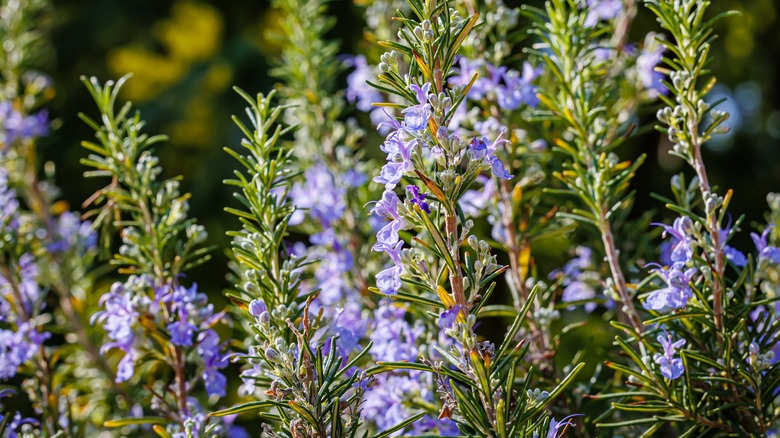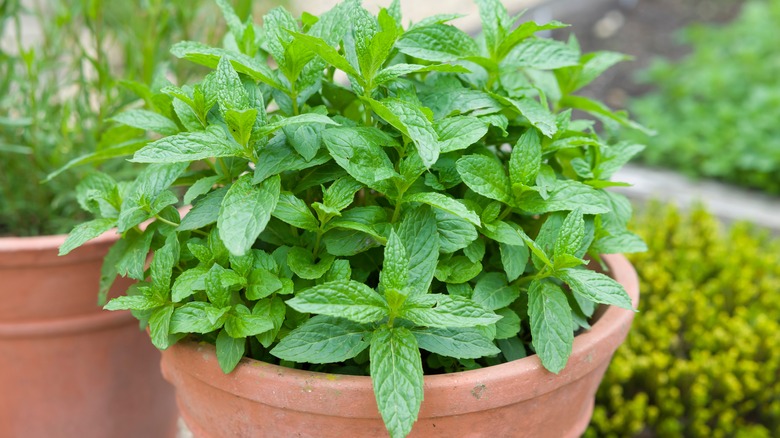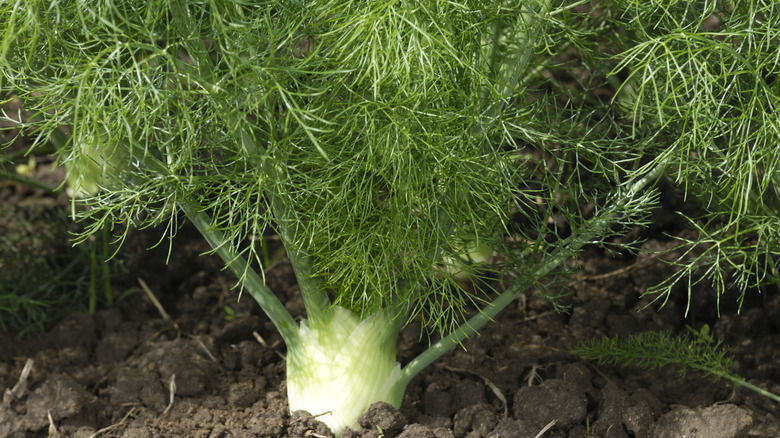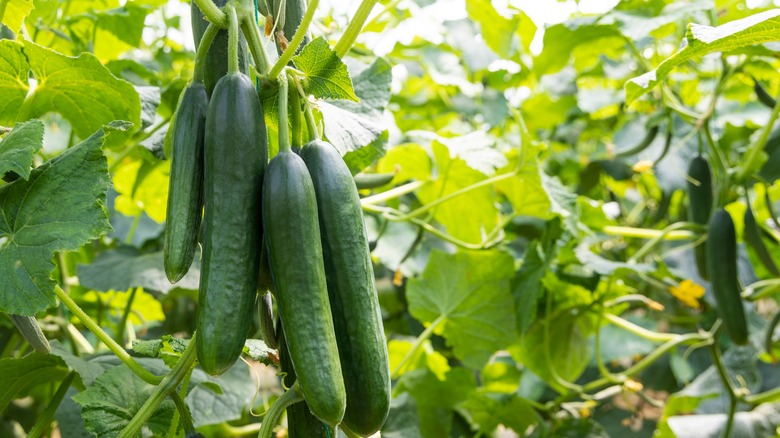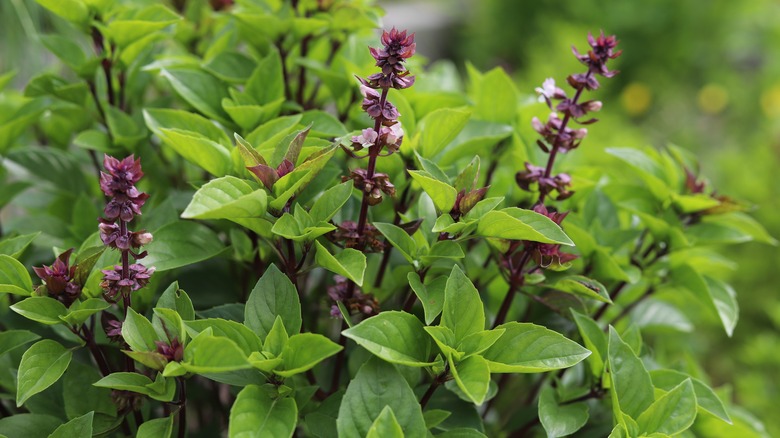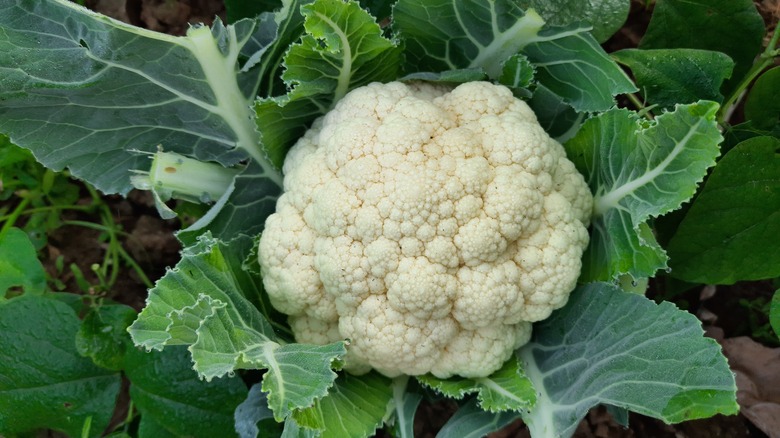Vegetables And Herbs You Shouldn't Grow With Rosemary In The Garden
As another gardening season unfolds, one of the most difficult decisions to make — especially for new gardeners — can be choosing which plants to grow together. While it might seem sensical enough to group plants based on attributes like season or aesthetic, there are deeper matters to consider. This is where companion planting comes in. Companion planting is the practice of strategically grouping together plants that offer health benefits to each other and spacing out those that could negatively affect one another.
Considering the best companions for your plants doesn't only benefit the plants themselves — it improves the health of your garden's soil over time as well. Planting corn and beans together, for example, provides the beans with shade and a natural surface for climbing. In return, the beans produce a nitrogen boost for the corn's soil. If you're planning to grow rosemary in your garden, there are several options for companions, including sage, thyme, and carrots. There are also numerous plants that do not pair well with rosemary, including other popular herbs like basil and fennel. Consider this your guide to what not to plant with rosemary.
Mint will overtake rosemary
Mint is a very popular herbaceous perennial often showcased in Mediterranean cuisine, desserts, teas, and cocktails. It's also often used to naturally repel mice from homes and gardens. While there are many different varieties of mint available, nearly all of them produce either purple or white flowers that attract pollinators. Generally speaking, mint grows quickly in nearly any soil or light conditions, and it also spreads aggressively. Unfortunately, this is in direct opposition to the way rosemary grows. Rosemary spreads slowly to moderately and requires both full sun and dry, sandy soil to thrive.
If you plant mint with rosemary, expect it to overtake the rosemary. Instead, try planting your mint with other edible plants that are hearty and vigorous, and that can benefit from mint's natural pest-repellent qualities. A few such options would include peas, onions, tomatoes, or broccoli. You may also wish to grow mint in pots, since it can be difficult to contain in a larger area.
Fennel can stifle rosemary's growth
Fennel is a tender perennial herb, meaning that it is grown as an annual in most climates. It is an incredibly versatile herb with bulbs, fronds, flowers, and seeds that are all edible. The plant has an anise or black licorice flavor that is bolder or milder depending on which part is being consumed. Fennel's yellow flowers will also attract pollinators to your garden. This useful herb requires moist nutrient-rich soil, unlike rosemary.
Rosemary thrives in soil that is not only dry and sandy, but also low in nutrients. This means that planting these two herbs next to each other will leave at least one of the plants struggling to survive. Since fennel is allelopathic — meaning it produces chemicals that can inhibit the growth of some nearby plants — the plant that loses the battle will likely be rosemary. Try pairing fennel with sage or lettuce instead, since these plants have similar sun and soil requirements and aren't affected by the herb's chemical compounds.
Cucumber and rosemary won't thrive together
Cucumber is one of the most beloved summer gourd fruits you'll find in any vegetable garden. This tender annual is often enjoyed raw in salads or pickled, and it produces flowers that are attractive to honeybees. In order to grow the watery fruits that we all know and love, cucumber plants require heavy feeding and abundant water. This, of course, is in direct opposition to rosemary's need for dry, low-nutrient soil.
In addition to the incompatibility of cucumber and rosemary's soil requirements, there is the matter of rosemary's mildly allelopathic oils. A plant as delicate as cucumber cannot thrive with these inhibitory chemicals nearby. Instead, try planting your cucumber near your corn, dill, or sunflowers. These plants have high water and nutrient needs — just like cucumber — and aren't susceptible to rosemary's mild allelopathic nature, making them excellent companion plants that won't interfere with your summer cucumber harvest.
Basil and rosemary just don't get each other
Basil is a timeless annual herb in the mint family that is commonly used in both its fresh and dried forms as seasoning, especially in Italian dishes. In addition to their pungent edible leaves, basil plants produce tiny bee-attracting flowers. Most gardeners remove these flowers to redirect the plants' energy to greater leaf production. Basil is a true summer annual that requires heavy fertilization and abundant water.
The need for moisture and nutrients places basil in the category of plants that exist in opposition to rosemary. Planting rosemary in soil that is ideal for basil will result in overwatering and overfertilization, which can lead to root rot, powdery mildew, and nutrient scorching. Planting basil in soil that is ideal for rosemary will leave the basil dehydrated and nutrient deficient, creating the potential for yellowing or even blackening of its tasty leaves. Try pairing your basil with plants that love water and nutrients as much as it does, like asparagus, chamomile, or chives.
Tomato plants need too much water for rosemary
The tomato plant is a very tender summer annual that produces well-known and well-loved juicy red nightshade fruits. Tomatoes are incredibly versatile and are often eaten raw, cooked, canned, used in sauces, and juiced for drinking. Tomato plants require frequent heavy feeding and abundant water at all times to thrive. This — as you've likely gathered by now — is incompatible with rosemary's need for dry, well-draining, low-nutrient soil.
Tomato plants cannot survive in soil that is dry and low-nutrient enough for rosemary. On the other hand, rosemary will not flourish in the type of moist, humid, nutrient-dense conditions that tomato plants require to grow healthy tomatoes. Therefore, it is best to plant these two popular garden staples in different areas of your garden, unless you wish to grow one or both of them in containers. If you prefer planting both in the ground, opt for marigolds, zinnias, or basil near your tomatoes, instead of rosemary.
Cauliflower can spread disease to rosemary
Cauliflower is a cruciferous vegetable in the mustard family that is often eaten either raw or cooked whole, puréed, or riced. While cauliflower does require much cooler and moister soil conditions than rosemary does, this isn't the only reason the two popular plants shouldn't be placed next to one another. In addition to these key differences in soil preferences, both cauliflower and rosemary plants are prone to developing fungal infections.
Much like humans and other animals, plants can pass diseases to each other based on their proximity to one another. Since both plants are susceptible to fungal infection, the two are likely to spread harmful fungi to one another if one of the plants becomes infected. As a result, you could lose both your rosemary and your cauliflower when the two are too close together. Instead, place your cauliflower near plants that aren't as likely to fall victim to fungal infections, like garlic, onions, or chives.
